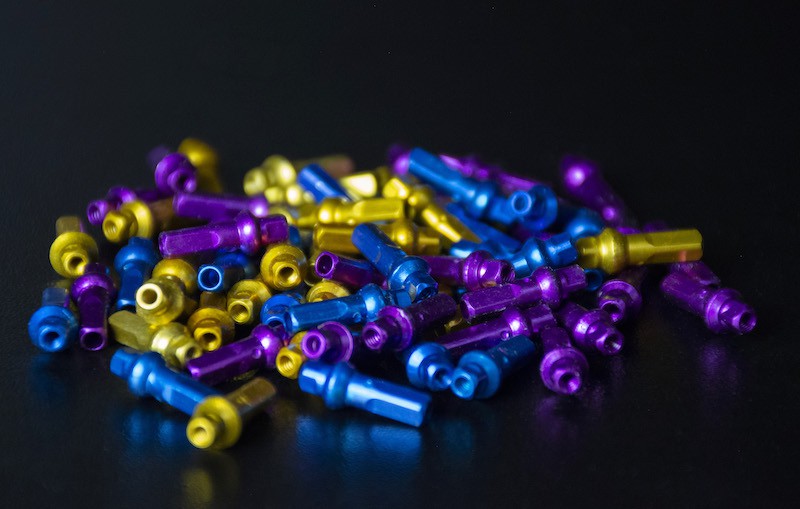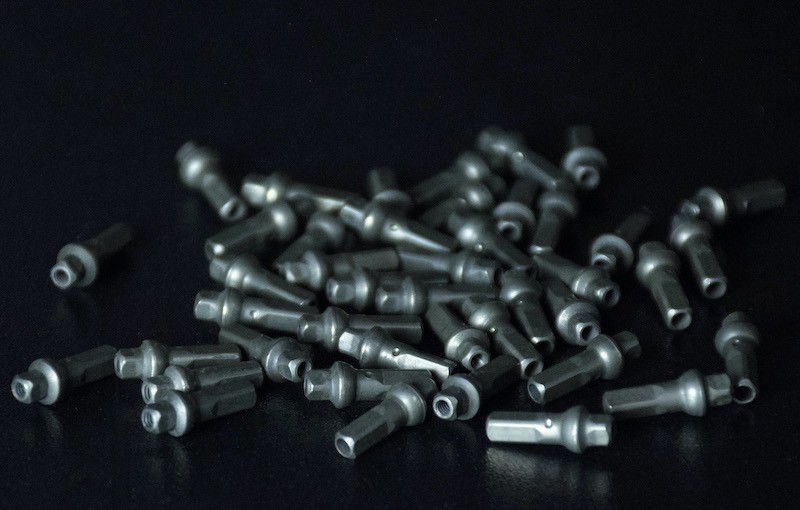
Brass Vs Alloy Nipples
What’s the difference between brass and alloy nipples? Why are there two material types, and which one is better?! It’s a question as old as time, or at least as old as the bike wheel.
Because every wheel we build at NOBL is fully custom, we place a ton of value on building with the best components in the world. Spoke nipples are no exception.
What To Look for When Choosing a Nipple?
The characteristics we look for in a nipple are:
- Durability
- Corrosion Resistance
- Maximum thread engagement
- Strong nipple heads
- Effective interface with the rim
- A locking mechanism to secure thread position and
- Spoke twist or windup Reduction
We exclusively use Sapim Double-Square Polyax Secure Lock Nipples in the shop, because they offer the best performance possible in each one of these categories.
These nipples are unique in that they have quite a bit more thread engagement than a traditional flat head nipple. Their Polyax shape makes a better connection between the nipple and the rim which allows spokes to move and line up more easily. They also feature a unique coating that reduces spoke twisting or windup during the building process. While different materials might vary in strength and corrosion resistance, Sapim nipples are renowned for their class leading longevity.

Alloy Nipples come in a variety of colours.

Brass Nipples only come in Black and Silver.
Why Choose Alloy?
So, you can rest assured your wheels will be built up with great nipples no matter what, but now you’re left with a decision between two different material types: Brass and Alloy.
This normally leads to some pretty lengthy discussions about but this is usually how they go:
AlloyFan71 – “Alloy nipples are lighter, and I want to save weight, so they must be the best!”
BrassBoss47 – “Nope, alloy corrodes after contact with water, so the nipples become brittle and snap over time. Brass is heavier and more durable which means it’s stronger!”
This is one of the most common questions we field from customers, and We’re happy to confirm that the best choice for the vast majority of riders is an Alloy nipple, provided it’s made by Sapim. Their heat-treated 7075 T6 alloy nipples are far superior to the older options, and their strength and durability have even surpassed that of traditional Brass ones. They also feature an anti-corrosive treatment and won’t become brittle over time as older alloy options did.
Alloy nipples are also far lighter than their brass counterparts. In fact, a full wheelset’s worth of brass nipples comes in at 77g vs only 24g for an alloy set. Keep in mind, this weight is rotational, which means you’ll feel the difference a lot more than you would adding the 53 grams to your hub or something at the center of your wheel. Depending on your objective, 53g may or may not be a huge deal, but it’s definitely worth mentioning.
Also worth mentioning is that these alloy nipples don’t round off at the head as easily as the brass ones do when you’re adjusting spoke tension. This is definitely something to keep in mind if you’re thinking about wheel maintenance down the road.
When to Choose BRASS?
So, if alloy is a better option for most riders, when should you use brass? While on balance, both materials are extremely durable and corrosion resistant, the brass still holds a slight edge. We’d say that if you’re building up a bike that’s going to see a lot of exposure to road salt, or be ridden directly on the beach, we’d still build with brass.
So there it is, the age-old debate has finally been settled! If you have more questions about the nipples we use, or just want some help building up your next set of dream hoops, please reach out through ride@noblwheels.com and we’ll be in touch!